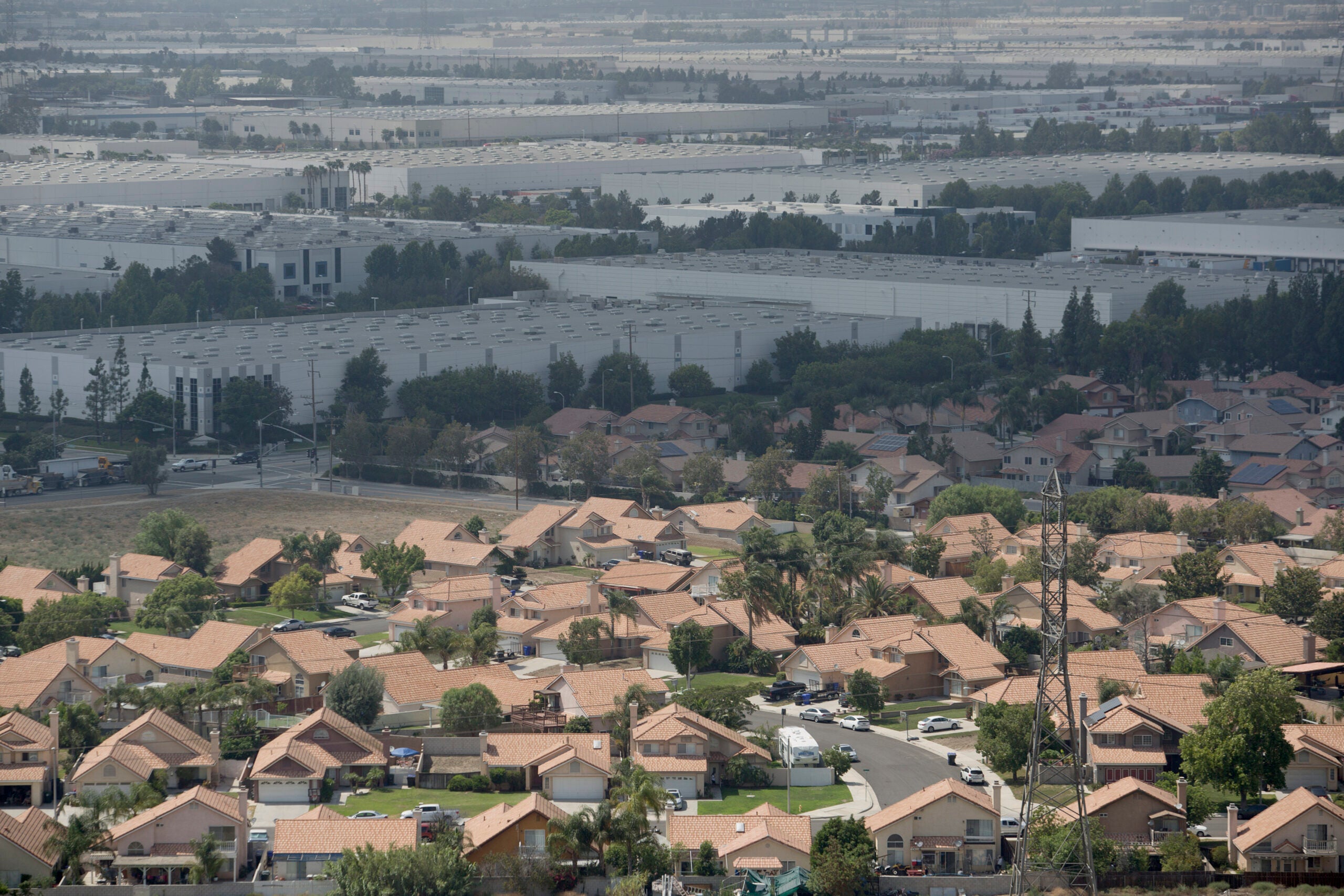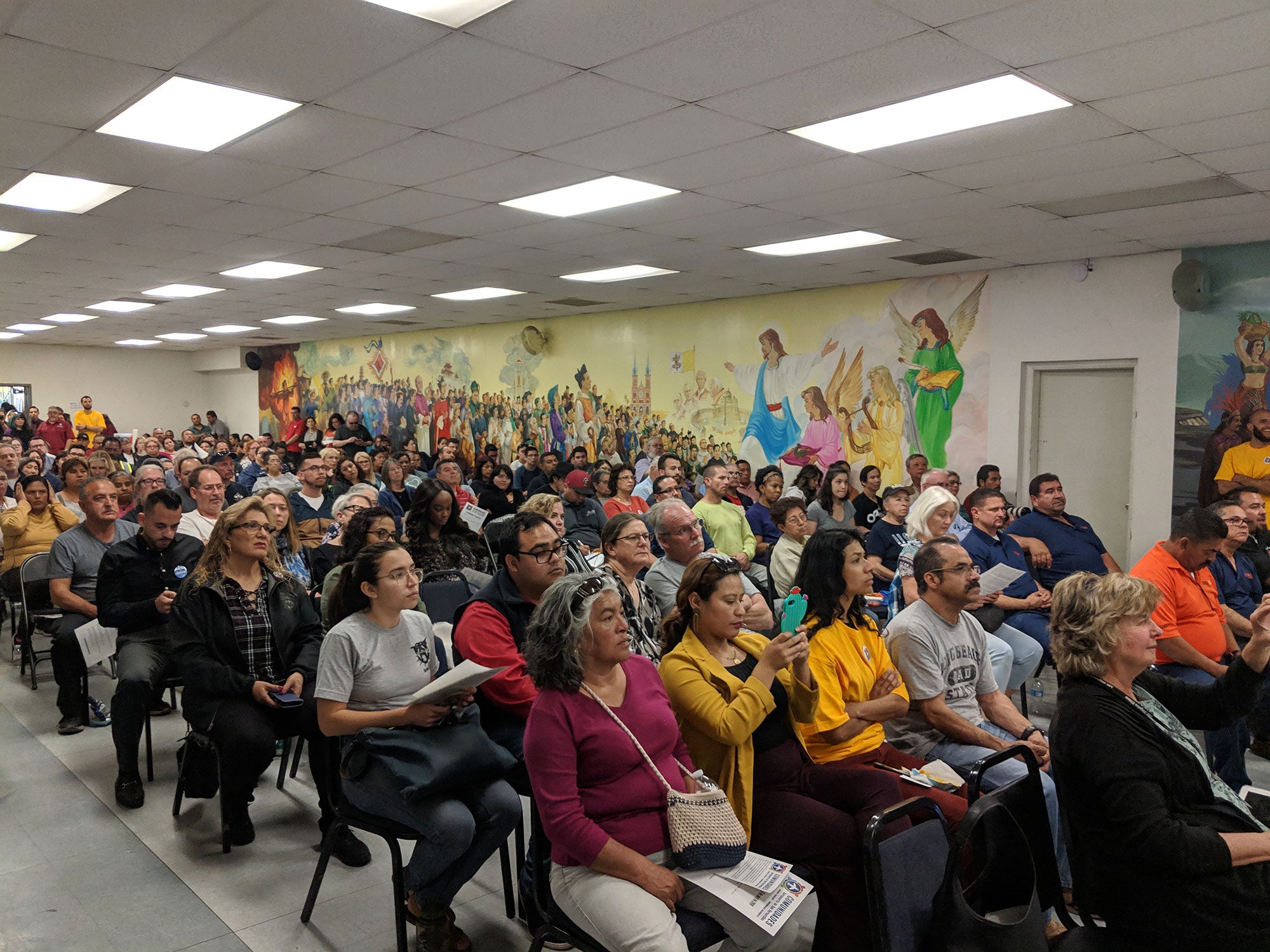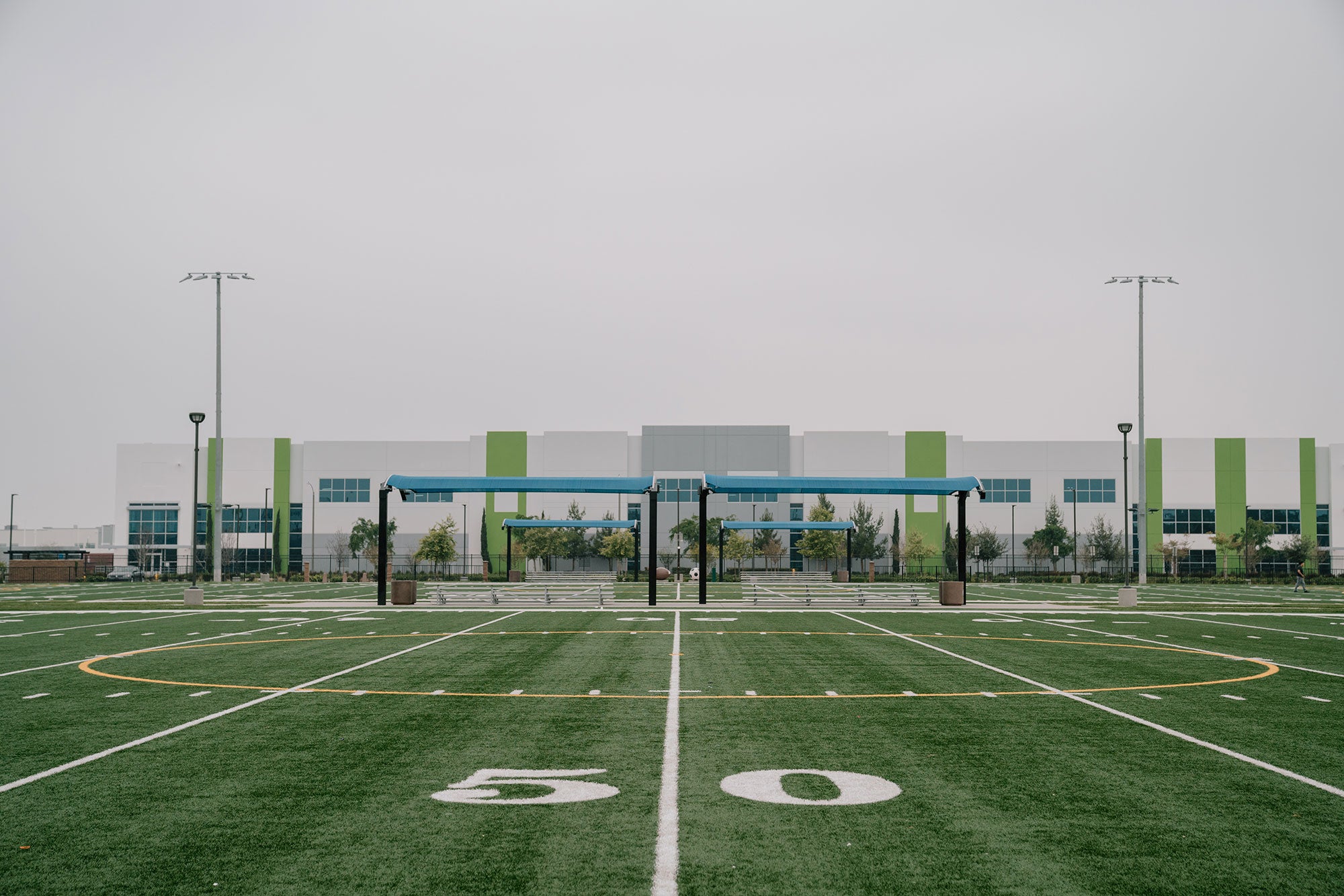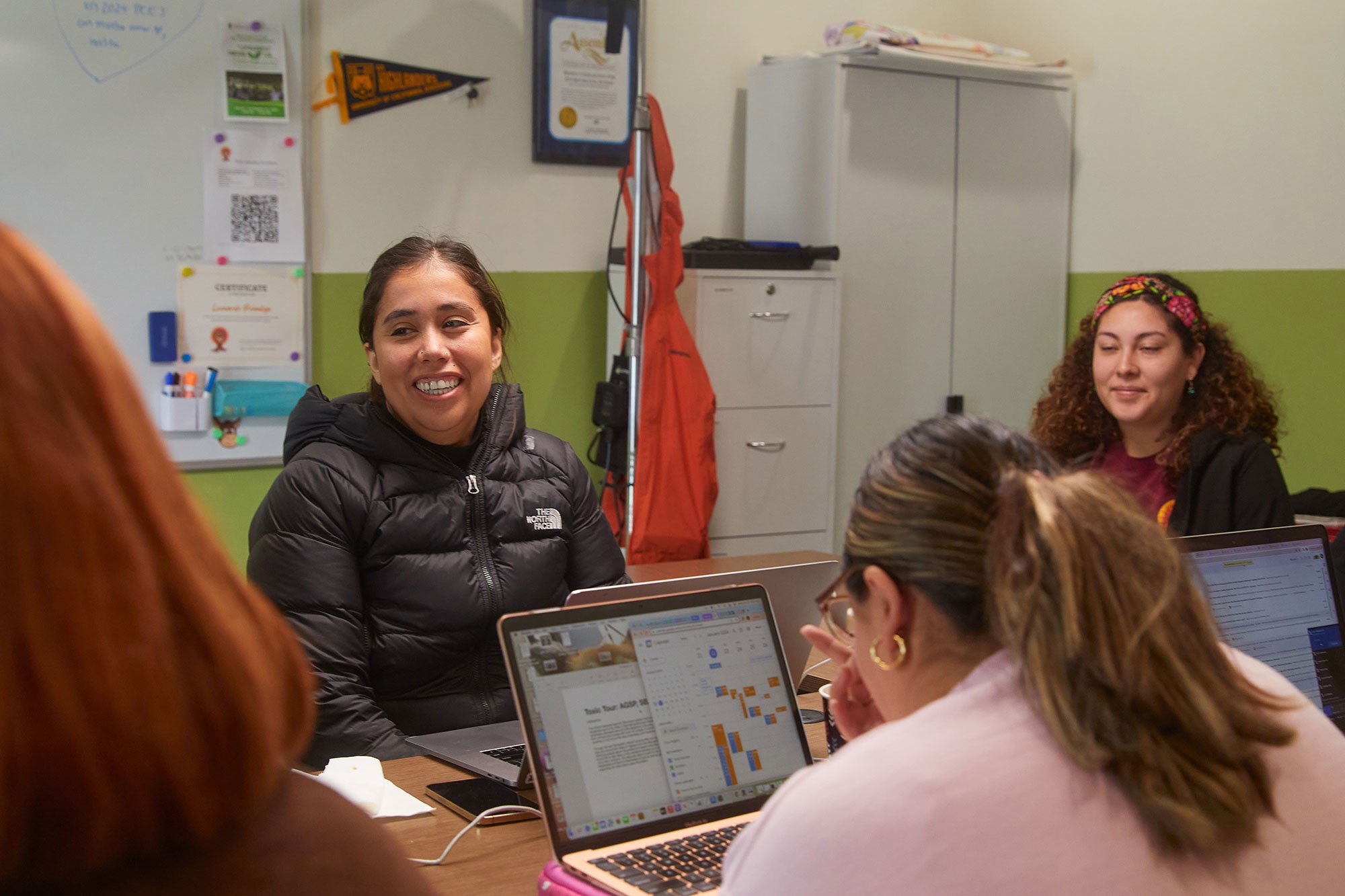Vidaurre speaks at a rally for clean trucks in Sacramento, Calif. (Chris Jordan-Bloch / Earthjustice)
April 29, 2024
Fighting to Breathe: Andrea Vidaurre is Taking on the Freight Industry’s Pollution from California to Washington, D.C.
“People should care about what’s going on here because all of us benefit from the goods movement system — no matter where you live.”

Andrea Vidaurre is a co-founder and policy analyst with the People’s Collective for Environment Justice and a 2024 recipient of the prestigious Goldman Environmental Prize. She’s a lifelong resident of the Inland Empire of California, an area sixty miles east of Los Angeles that includes the cities of San Bernardino and Riverside. Known historically for its abundant farmland, the region is now the epicenter of the global shipping industry. Over 9,500 mega warehouses dot the landscape alongside miles of railyards, trucking corridors, and high-traffic freeways located mere feet from houses, schools, community centers, and playgrounds.
The growth of the industry has worsened air quality, cancer rates, and other health issues in the Imperial Valley. An estimated 700,000 diesel trucks pass through the Inland Empire each day, and San Bernardino and Riverside were ranked the first and second most ozone-polluted counties in the nation in 2021. The high rates of asthma, chronic obstructive pulmonary disease, lowered lung function, high blood pressure, and certain cancers have led physicians to dub these areas “diesel death zones.”
Andrea and the People’s Collective for Environment Justice have been key partners with Earthjustice’s Right To Zero campaign in the fight for zero emissions. Upon winning the prestigious Goldman Environmental Prize, Andrea sat down with Earthjustice to discuss her work and her vision.
You’re born and raised in the Inland Empire and have dedicated your work to improving the health, well-being, and economic outcomes of its residents. How has your background growing up in the area influenced your work?
Like many in the Inland Empire, I didn’t recognize the immediate impact of industry on our community. Many of our families work in the industry. We live close to these places, and for much of my life, it seemed normal.
As I grew older, I started to travel a bit more out of the area and started seeing the differences between cities. There were certain cities where industry seemed nonexistent. You wouldn't see as much trucking, freight shipping infrastructure, or warehouses as you would see in the Inland Empire. You also didn’t see many people of color living in these places.
The Inland Empire is a community of hard-working immigrants. Many come here looking for a better life and work hard while being resourceful. While a lot of my family is in Peru, my immediate family found a community here, and this community invested in me. These experiences shaped my understanding that there was something specific happening in our communities versus others. I wanted to get involved.
One of the main issues in the Inland Empire is freight air pollution. On a bad air day, you can’t see the mountains that ring our community. The air feels thick, heavy, and difficult to breathe. Breathing gives you a tingling sensation in your forehead, sometimes a severe headache. Taking a deep breath of air should feel soothing, but in our community, it feels like the air is tainted.

Many of us advocating for zero-emissions freight use the phrase, “We’re just trying to breathe.”
That phrase came from East Yard Communities for Environmental Justice, and I learned a great deal about advocacy from them and other groups like the Moving Forward Network. These groups represent communities that are also dealing with high levels of freight pollution and have fought polluting industries for decades.
The power of this phrase is its simplicity. We’re asking for what all living things do, and that’s to breathe. It’s human nature, and all of us who live in this area deserve to breathe clean, healthy air.

For those who live far from the warehouses, the highways, and the freight corridors that underpin the global shipping industry, what do you want them to know about the impacts of freight pollution on health?
People need to know that the impacts are deadly, and I'm not using that word lightly.
It’s the cumulative impacts of these facilities that make the environment so fraught. It’s one thing if you’re just dealing with one pollution source like a railyard, a freeway, or a warehouse. But we’re dealing with multiple sources, and we’re literally boxed in by giant stretches of warehouses, large polluting trucks on every street and highway, and railroad tracks throughout our cities. These are all next to three major freight freeways that move goods throughout our communities back and forth all day. We’re oversaturated here.
People should care about what’s going on here because all of us benefit from the goods movement system — no matter where you live. Every place has food in their grocery stores. Most everyone can get stuff delivered directly to their door. We all benefit, no matter if you live 50 feet from a freight corridor or if you live 500 miles from freight.
But we’re the ones facing the consequences and experiencing the costs of this goods movement system. It doesn’t have to be this way. We can do shipping without some of us paying with our lives.

You helped build an impressive coalition that was pivotal in the passage of the California Trucks Rule in 2020 to shift to zero-emissions trucks. What strategies did you find to be the most helpful in your advocacy with decisionmakers?
The most effective strategy was connecting decisionmakers to the people most impacted by freight pollution. We did this not just through visits to the State Capitol in Sacramento, but by bringing decisionmakers to places like the Inland Empire to see the issue themselves. We needed them to walk our streets, see the freight infrastructure, and breathe the air we breathe every day.
It’s easy for policymakers to get clouded by industry talking points, scare tactics, and quite frankly, expensive lobbying efforts. We needed to break through the noise and show them how rigged the system is against our communities. Decisionmakers tend to make rules based on what they believe is feasible and what will have the smallest disruption to the status quo. This is unacceptable when the system is the problem.
We had to break that mindset, and that power came from storytelling. We connected community members to decisionmakers to tell their stories and lived experiences while also explaining what they see as possible solutions.

Central to this storytelling piece was working with other impacted communities to strengthen our message. Freight pollution impacts communities across California. We did a caravan to get community voices to Sacramento to speak directly to policymakers and demonstrate the far-reaching impacts of freight pollution.
We set off with a van full of people from the Inland Empire and a van full of folks from Los Angeles and drove to Oxnard, California, to meet with those affected by the port expansion. We then went to the Central Valley where they are experiencing a massive buildout of warehouses and trucking and linked up with more people. We traveled to the Port of Oakland and met with those who had dealt with the port’s expansion. It was an amazing way for our communities to share their experiences, recognize similarities, and collectively show up for each other in Sacramento. When we finally arrived there, we held a rally and attended meetings and hearings. When they tried to restrict us to only two minutes of speaking time, we demanded more so that the voices of people who had spent two days traveling to Sacramento would have the opportunity to tell their story.
People, and especially policymakers, are always talking about the value of time. They are right. Time is important, and we took the time to show up and tell them about the deadly impacts we face. Our time is valuable too.
The freight and the warehouse industries have often portrayed themselves as bringing jobs and development to economically distressed areas. Is this the case with the Inland Empire?
Industry uses this talking point to claim that it’s bringing in jobs and infrastructure to areas that have historically received very few investments. But at what cost?
The trade-off we’re being asked to make is with our health. This is the heart of environmental racism because this trade-off is unacceptable in other communities. In large parts of this country, mostly middle class, wealthy, and whiter areas, residents would never be asked to sacrifice their quality of life and health for employment. Communities like mine in the Inland Empire are forced to accept this reality every day.

Industry also blames us as consumers for sustaining their industry. They blame our shopping habits, the pandemic, and the rise of e-commerce, but that's not the full story. These are part of the problem, but its source is the industry’s greedy quest for profit.
A few years ago, we lived without next-day shipping, and it was not the end of the world. These companies drive a culture of consumerism to maximize their profit. They grow the railyards, the warehouses, the freeways, and trucking corridors to shove more goods down our throats, and they run it all with polluting combustion vehicles. We also know that our communities here in the Inland Empire and similar places consume the least from these companies.
The other piece about these jobs is just that they are historically low-paying jobs and often temporary. Many warehouses use temp agency models that strip workers of their rights to organize, to get paid a higher wage, or even claim medical benefits. People go for years without seeing a pay increase.
On top of that, these workplaces are dangerous places to work. The pace of work is frantic, and it’s a constant race to see how fast and far they can push the human body. They’re plagued by high injury rates, accident rates, and there are instances of people losing limbs, facing serious injuries, or becoming permanently disabled. There’s rampant wage theft and extreme surveillance to prevent workers from organizing for better working conditions and protections. That’s the reality of these facilities that people fail to discuss when articulating the economic benefits.
And it’s hard because so much of our local economy is based on these jobs. Industry knows that people will still take them, despite the conditions and risks. My mother, father, and brother have worked in the industry at some point in their careers. It’s put food on the table for my family and countless others. But there were so many years of struggle, and the conditions didn’t have to be the way they were.
When a city or county is negotiating with a warehouse or shipping entity to come in, they need to look beyond the number of jobs and understand the quality of the jobs being offered.
Why do you think there’s so much concentrated advocacy for zero emissions in California?
The modern freight system has historic roots in California going back decades, and so do the grassroots movements that oppose them.
Grassroots organizations in LA, Long Beach, and the South Bay created community and data reports, came up with phrases like ”diesel death zones,” and worked with scientists to demonstrate the threats of diesel pollution to public health. Many of these people I’ve heard of only by name. They never saw the fruits of their labor.
Today, we have the technology, political will, and investment to act, but the movement itself is the product of historic work — not just in the Inland Empire, but in communities across the country like those in Kansas, Chicago, Oakland, and Newark.

Following the success of the zero-emissions truck rule, you’ve been focused on pollution at warehouses, ports, and other parts of the freight system. What’s next for you?
The fight has just begun. Passing these rules is incredibly important, but there’s no point to them if we don’t follow through on the implementation. If we do nothing, we’ll never see the changes fully realized. We need to continue to strengthen these rules and ensure California is doing everything it can to be a leader in zero-emissions standards.
We’re also undertaking a campaign to reform the Low Carbon Fuel Standard to make sure it’s funding transportation electrification instead of false solutions that rely on combustion, like biomethane and biofuels. We’re talking about one of the largest pots of climate dollars in California, and it’s mostly going to polluting fuels. We need to fix that.
What is your vision for the future of the freight system in the United States when it comes to air pollution?
We need to modernize our rail systems, and that requires federal action. It’s time to build out an electrified rail system, which means putting catenary lines on locomotives, making it more sustainable to move more things, and getting more trucks off the road. We’ve made progress with California’s new zero-emissions locomotives standard, and it’s time to make inroads nationally.
We should also talk about localizing sourcing in various communities. There is no reason why communities like the Inland Empire should be shouldering the consumer burden for 40 percent of the country. There needs to be a redistribution of the burden, and that will come from making sure that we’re not sacrificing environmental justice communities.
There’s a possibility to transform the way we ship goods in this country at all parts of the supply chain from the ports, to trains, to trucks, and warehouses. I believe we can create the political will to get there.
You’ve just won the Goldman Prize for your work. What do you want national policymakers to know about your coalition’s work to end freight pollution in California? What do you want them to take away from all of this?
I want them to realize that communities know the solutions to the big problems we face.
National policymakers need to include impacted communities in the conversation on freight pollution early and often because it’s the only way we can come up with solutions that receive community buy-in from the start. Communities like mine do not deserve to be sacrificed in the name of global commerce.
We also need the U.S. Environmental Protection Agency to approve the California waivers that allow the state to set strong standards for emissions reduction and allow other states to opt in to those stronger standards. California has been a leader in listening to communities and implementing strong rules to lower emissions and reduce air pollution. We need these waivers to keep up the momentum and inspire other states to join the transition.
Finally, grants and incentives are great, but regulations are long-lasting even after the money runs out. If you’re throwing money at a problem while failing to implement or enforce a regulation, what are you doing to guarantee long-term success? Money runs out, but regulations result in structural changes.
Structural change is the only way we’re going to achieve a goods movement system that works for all of us.

Chris Jordan-Bloch is a photographer and filmmaker for Earthjustice. He uses videos, photos, audio and words to tell the stories of Earthjustice and the people and places we fight to protect.
To tackle our climate and air pollution challenges, we have to electrify everything and power it all with 100% renewable energy. A transition that once seemed impossible even a decade ago is now reshaping our lives. The Right To Zero campaign is working to accelerate this clean energy, clean air transition.